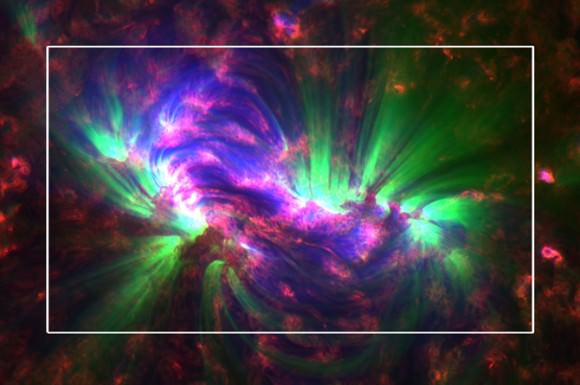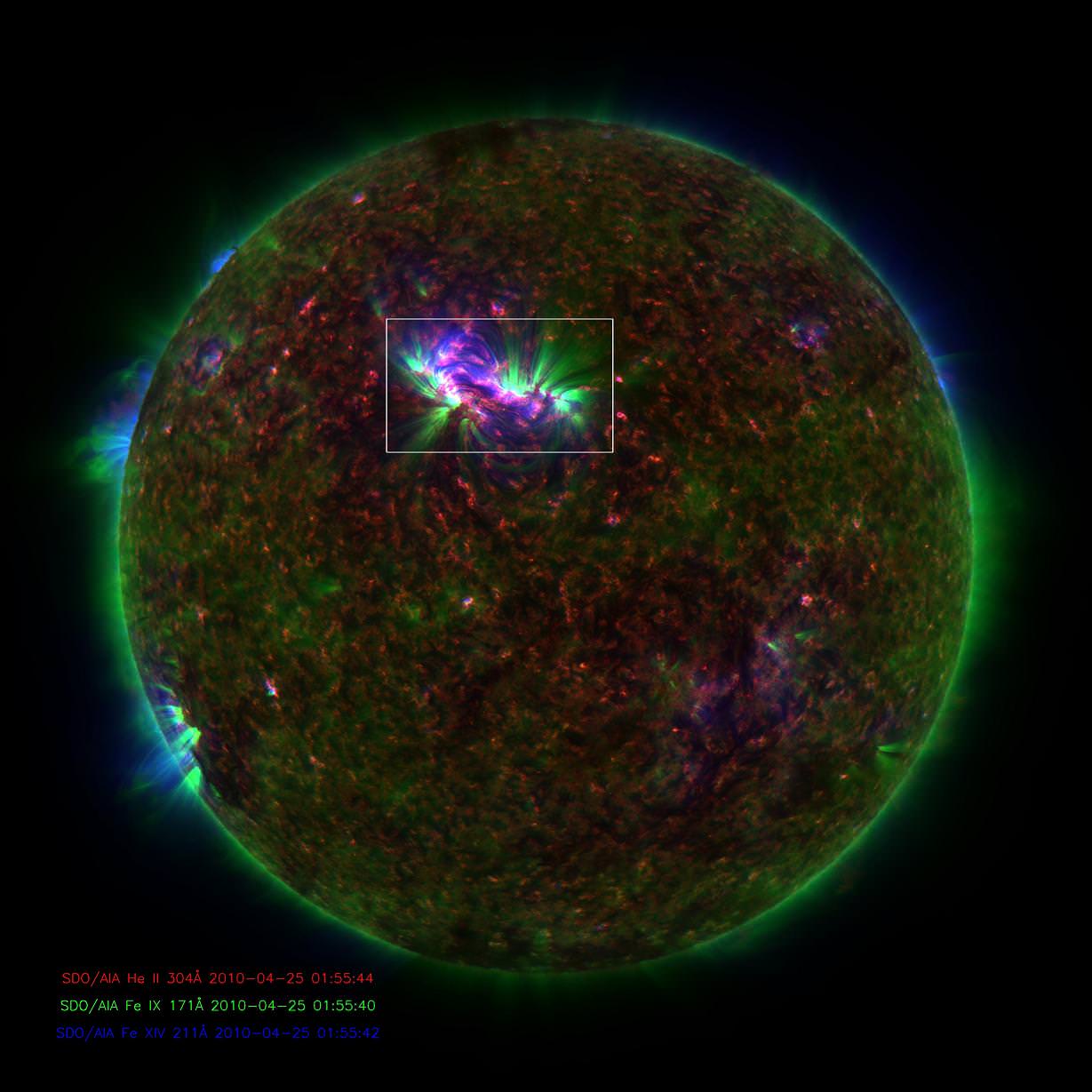[/caption]
Have you ever seen the hot summer wind blow across a ripening field of wheat? If so, you’re familiar with the rippling effect. Now imagine that same crop – only the stalks are 32,000 feet high and on the surface of the Sun. This cascading effect is called Alfvén waves.
Thanks to NASA’s Solar Dynamics Observatory (SDO), we’re now able to see the effect of Alfvén waves, track their movements and see how much energy is being carried along. These new findings have enlightening solar researchers and may be the key to two other enigmatic solar occurrences – the intense heating of the corona to some 20 times hotter than the Sun’s surface and solar winds that blast up to 1.5 million miles per hour.
“SDO has amazing resolution so you can actually see individual waves,” says Scott McIntosh at the National Center for Atmospheric Research in Boulder, Colo. “Now we can see that instead of these waves having about 1000th the energy needed as we previously thought, it has the equivalent of about 1100W light bulb for every 11 square feet of the Sun’s surface, which is enough to heat the Sun’s atmosphere and drive the solar wind.”

As McIntosh points out in his July 28 Nature article, Alfvén waves are pretty simple. Their movement undulates up and down the magnetic field lines similar to the way a vibration travels along a guitar string. The plasma field enveloping the Sun moves in harmony with the field lines. The SDO can “see” and track this movement. Although the scenario is much more complex, understanding the waves is key to understanding the nature of the Sun-Earth connection and other less clear cut questions such as what causes coronal heating and speeds of the solar wind.
“We know there are mechanisms that supply a huge reservoir of energy at the sun’s surface,” says space scientist Vladimir Airapetian at NASA’s Goddard Space Flight Center in Greenbelt, Md. “This energy is pumped into magnetic field energy, carried up into the sun’s atmosphere and then released as heat.” But determining the details of this mechanism has long been debated. Airapetian points out that a study like this confirms Alfvén waves may be part of that process, but that even with SDO we do not yet have the imaging resolution to prove it definitively.
Hannes Alfvén first theorized the waves in 1942, but it wasn’t until 2007 that they were actually observed. This proved they could carry energy from the Sun’s surface to the atmosphere, but the energy was too weak to account for the corona’s high heat. This study says that those original numbers may have been underestimated. McIntosh, in collaboration with a team from Lockheed Martin, Norway’s University of Oslo, and Belgium’s Catholic University of Leuven, analyzed the great oscillations in movies from SDO’s Atmospheric Imagine Assembly (AIA) instrument captured on April 25, 2010. “Our code name for this research was ‘The Wiggles,'” says McIntosh. “Because the movies really look like the Sun was made of Jell-O wiggling back and forth everywhere. Clearly, these wiggles carry energy.”
The “wiggles” – known as spicules – were then modeled against Alfvén waves and found to be a good match. Once pinpointed, the team could then could analyze the shape, speed, and energy of the waves. “The sinusoidal curves deviated outward at speeds of over 30 miles per second and repeated themselves every 150 to 550 seconds. These speeds mean the waves would be energetic enough to accelerate the fast solar wind and heat the quiet corona.” says the team. “The shortness of the repetition – known as the period of the wave – is also important. The shorter the period, the easier it is for the wave to release its energy into the coronal atmosphere, a crucial step in the process.”
According to preliminary data, the spicules leaped to coronal temperatures of at least 1.8 million degrees Fahrenheit. The pairing of Alfvén waves and heat may just be what it takes to keep the corona at its current temperature… but not enough to cause radiation bursts. “Knowing there may be enough energy in the waves is only one half of the problem,” says Goddard’s Airapetian. “The next question is to find out what fraction of that energy is converted into heat. It could be all of it, or it could be 20 percent of it – so we need to know the details of that conversion.”
More study? You betcha’. And the SDO team is up to the task.
“We still don’t perfectly understand the process going on, but we’re getting better and better observations,” says McIntosh. “The next step is for people to improve the theories and models to really capture the essence of the physics that’s happening.”
Original Story Source: NASA SDO News.


Yo Tammy, typo in the fourth paragraph, third sentence:
“… the Sun moves in harmony with he field lines.”
The US always tries to be exceptional – at all costs. 😉
corrected!
[rant] i understand completely about imperial vx. metric measurements. for the most part, i strive to use metric measurements – especially when writing science or for international audiences. the fault isn’t because the US tries to be exceptional… the fault is in our educational system. we simply weren’t taught – just as we weren’t required to learn alternate languages. as an adult, the burden of learning to “catch up with the rest of the world” falls upon the indivdual. those of us who are always seeking to improve our knowledge rise to answer the call. yet, sadly, there is a substantial portion of our population that isn’t exposed to the information, or simply doesn’t have the learning curve it takes. but these are good people – ones that deserve a chance to be informed – even if it means using an outdated form of measurement to make it understandable.
just think of how fortunate we are as a UT audience that we’re able to equate measurements and understand a great deal of other languages with ease! this membership shares some very complex thinking combined with a lot of good natured teasing and i marvel every day how much communication has changed in just my lifetime! let’s hope that through our continual and combined efforts that one day we all “speak the same language”. [/rant]
and that ivan3man is still around to make sure we do it right. 😉
Looks like they’re using watts per square feet too!
Yeah, I saw that too; however, at least one can relate to feet, inches, and miles – but friggin’ Fahrenheit?! It is just an arbitrary scale based on WTF?!
@I3M@L,
We all know the love for Celcius the science crowd has, but frankly it is an inversion of the original. I propose Kelvin for all, let’s hear it now folks!
Kelvin, Kelvin, we want you, Kelvin Kelvin, true to zero are we too!
Mary
At least the Celsius scale is defined in a meaningful way that is even usable for every-day life. The freezing point of water is freaking cold and anything below is even worse. The boiling point of water is freaking hot, and one should not place one’s hand into something with such a temperature.
I think, this is logical (and not meant too seriously 😉 ).
Kelvin is the right choice: It is right now 287,84K outside. Who doesn’t know what that means? 😉
@DrFlimmer,
I know, I know. It means time for ice cream, but I like ice cream even in the winter, so don’t use me as any scalar for measurement.
Personally, an all digital xxxxxxxxxx.001K reading Kelvin scale has got the analog version one beat by a portion of a mile. [pun intended indeed]
Mary
Yes.
Mind, as for calories et cetera, Celsius was created by and for chemists. Fahrenheit and such like was based on the tools available on a farm IIRC (mostly a massive horse body temperature used as the reference), so of old medicine use.
Fahrenheit can be dropped as non-standard, but Celsius is a standardized supplementary unit.
The Sun’s surface has a temperature of roughly 6000K. The corona is of the order of 1000000K. This is a factor 500 or so and not 20, isn’t it?
Still, science is closing in on the cause of that temperature jump. Good one!
You’re right, DrFlimmer, and I noticed that too, but the original NASA article has that same quote verbatim – they can’t even get their bloody factors correct!
It is my understanding that oscillating magnetic fields in the heliosphere heat up the plasma there. This might a form of Alfven waves. These are oscillating charge separations in a plasma due to an electromagnetic wave, or changing magnetic field. Ths oscillating magnetic field transfers energy to the charged species in the heliosphere and heat it up.
It is curious that Fahrenheit temperature measures are still used. For science and engineering it is beyond me why anyone would use anything other than metric MKS or CGS units, well except for Planck or natural units used in advanced physics. The English system is useful for ordinary life, where I could not imagine cooking in metric and Fahrenheit scale is more convenient for “weather temps,” and so forth. Yet it is curious that this nation can’t convert to metric for industrial uses.
LC
I think that a good analogy of the process is the domestic (magnetic) induction cooker.
A little of this (magnetic part of MHD), a little of that (ion dynamic part of MHD). Undoubtedly that is why the article express: “”The next question is to find out what fraction of that energy is converted into heat.””
i don’t thimk the world is going to end in 2012, but i think the sun is going to produce such a strong solar storm that is going effect all the electric components on the planet…………..
Good natured tease: “Alfvén waves are pretty simple”!?
Yes, as macroscale magnetohydrodynamic phenomena they are simple in principle. They are even the simplest (most basic) plasma wave, I believe.
But their derivation and their connection to other waves are not simple. It reminds more of similar plasmon connections in solid state physics. IIRC the basic plasma physics course, you typically walk through microscale dynamics of ambipolar plasmas and the ion cyclotron mechanism before you touch that!
Good natured nitpick: “Hannes Alfvén first theorized the waves in 1942, but it wasn’t until 2007 that they were actually observed. ”
I realize you didn’t mean to imply that, but Alfvén’s work isn’t connected to solar physics. The Wikipedia article gives enough history:
Alfvén waves were lab verified 1949, and first observed in space, or well, the ionosphere, 1958 if you go by man made, atomic bomb, induction or 1960 if you want the observation in nature. In fact I think Alfvén was more interested in the ionosphere at the time, or at least general plasma physics; but you may want to check me on that.
I’ll save the X nature comments until later. (`_´)